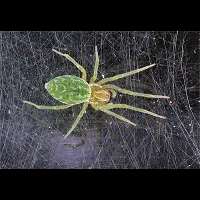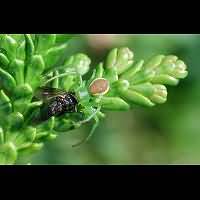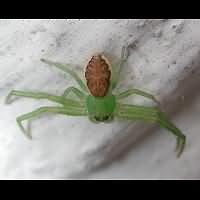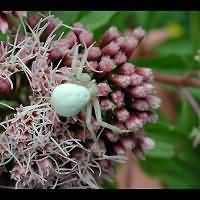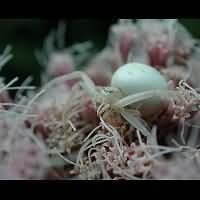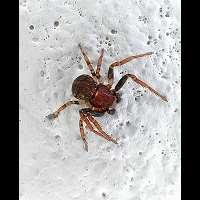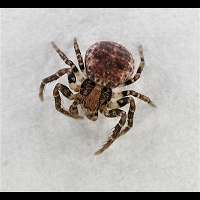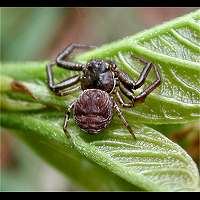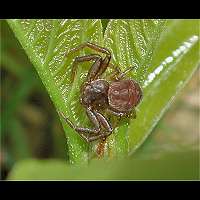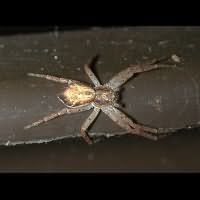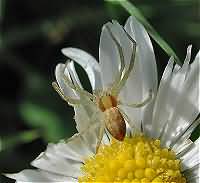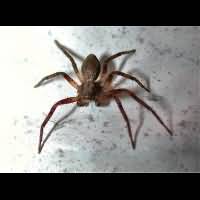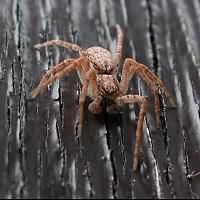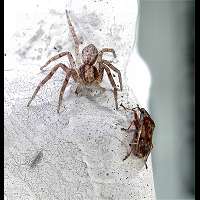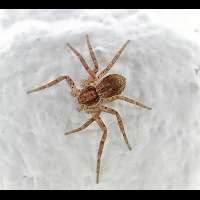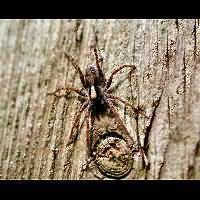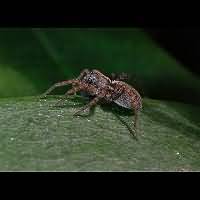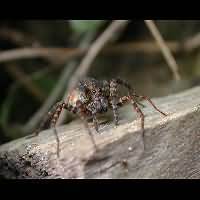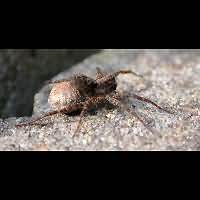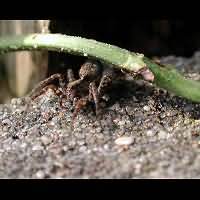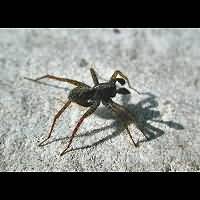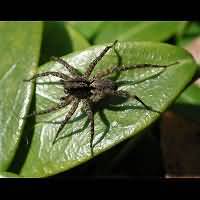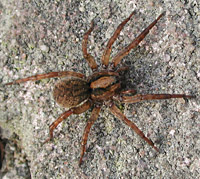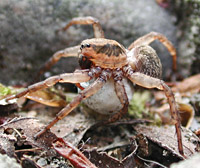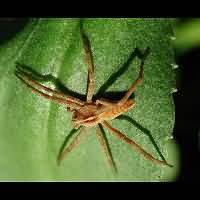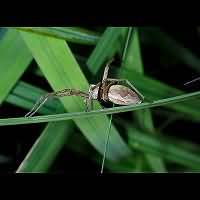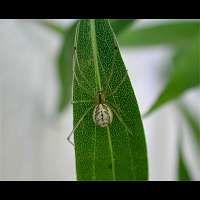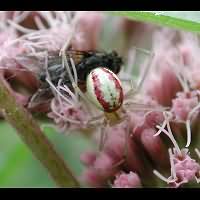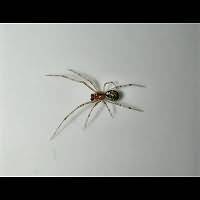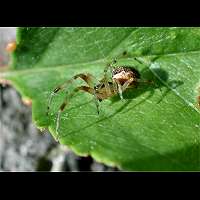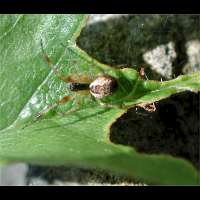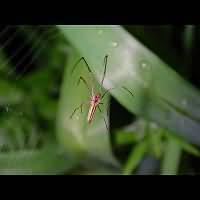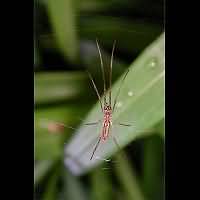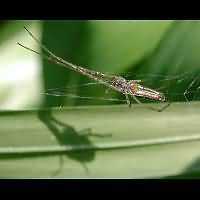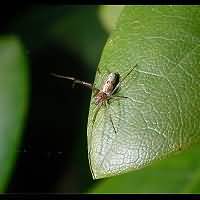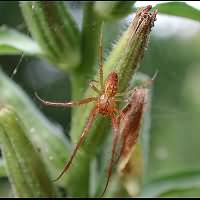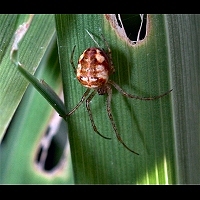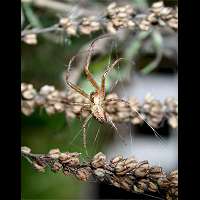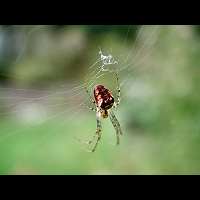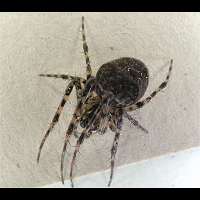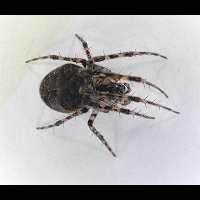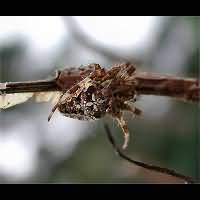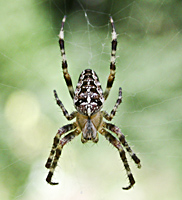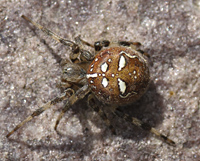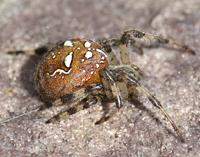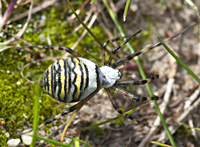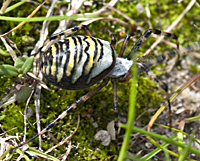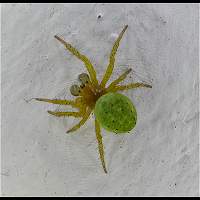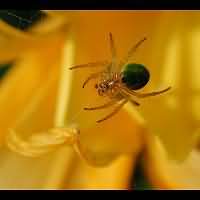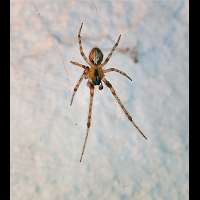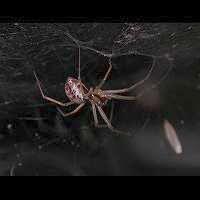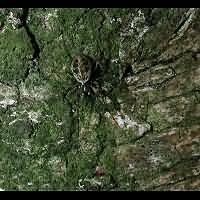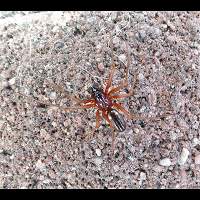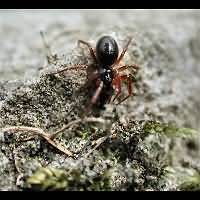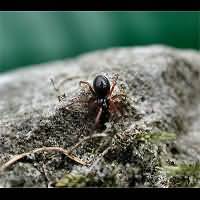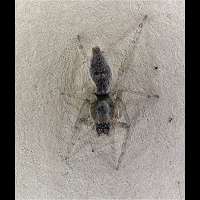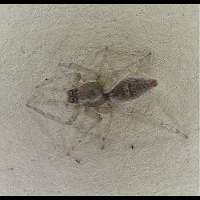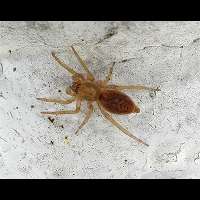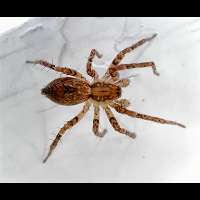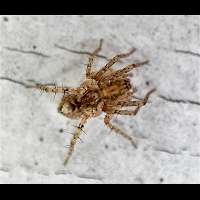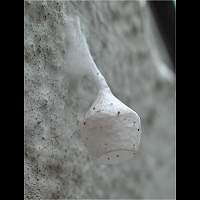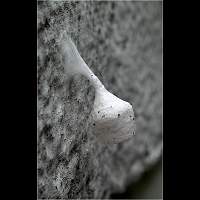[All pictures of garden wildlife on this page are thumbnails. Click on any thumbnail for a large format to be displayed.]
Garden Spiders
This page shows a collection of common spiders that can be spotted in an average garden. From time to time you can find these spiders on walls or fences and even indoors but during most part of the year you'll discover them among the plants or on the lawn. In search of the hideout for the winter some spiders climb walls and some others will even invade the house in autumn. The division into House Spiders and Garden Spiders on Gardensafari is far from being scientific. It is simply practical when trying to identify a spider according to the place it was spotted at.
Contents: 1 Meshweb Spiders 2 Crab Spiders, 3 Wolf Spiders, 4 Nursery Web Spiders, 5 Comb-footed Spiders, 6 Stretch Spiders, 7 Orb-web Spiders, 8 Sheet Web Spiders (Linen Weavers), 9 Dwarf Spiders, 10 Sac Spiders, 11 Buzzing Spiders, 12 Running Foliage Spiders.
![]()
1 Meshweb Spiders (Dictynidae)
This family of small spiders (most are merely 2 to 4 mm long) is also known as Cribellate Spiders or Mesh-webbed Spiders. Many species are attractively coloured and showing distinctive patterns on the bodies. Identifyication is often possible although in some cases you won't be able to determine only the genus. They build a small, robust web, usually on leaves and wait under it for their prey. For animals as small as these spiders, the prey is can be surprisingly big. The females are exceptionally gentle with the males. After mating they often live together for a couple of weeks, until he dies. Only then she will eat him although there are exceptions to this rule. The green species below is easily identified. The animal in the picture is a male. The female has a light green thorax. The markings on the abdomen differ clearly from those on the abdomen of other green species, such as the Cucumber Spider and Diaea dorsata, a Crab Spider. The web is usually build on big leaves. In spite of the striking colour this spider is rarely spotted. In the Benelux area this is a common species. In England it is a rather local species which can be found in London among other places.
This species, Nigma walckenaeri, is strikingly green, but yet very well camouflaged.
This family of spiders is always split up in two subfamilies: the Crab Spiders (Thomisinae) and the Running Crab Spiders (Philodrominae). Scientists don't agree whether it is correct to distinguish these two subfamilies or whether these are two separate families alltogether. Still, most believe in just one family. By the scientific name it is always easy to tell families and subfamilies apart: the names of families always end in '-dae', while the name of a subfamily always ends in '-nae'.
Contents: 2.1 Crab Spiders, 2.2 Running Crab Spiders
The crabspiders are a group of very colourful spiders that live in flowers and stalk or wait motionless for their prey. Their poison is very deadly to insects as it kills the vicim almost instantanously. Crabspiders have rather long legs and often walk sidewards, just like crabs do. They are smaller than the well known Garden Spider. Some species of Crab spiders can even change their colour adjusting it to the colour of the flower or plant they live on.
The beautiful, but well camouflaged crab spider is called the Green Crab Spider (Diaea dorsata).
Below a Crab Spider species that comes in various colours (it can even be striped!). In Dutch it is called the Chameleon Crab Spider. The animal in the picture does still have some colour around the eyes. The spider can be found in most larger gardens but it is not as common as the European Garden Spider. Some male Crab Spiders use a particular defensive tactics: they envelop the females prior to mating. The female can't move for a while and thus is unable to eat the male!
The Goldenrod Crab Spider (Misumena vatia), one of the best camouflaged spiders.
Some 12 species of Crab Spiders in the genus Ozyptila have been discovered in Europe. These are all small spiders, reaching the length of 3 to 4 mm only. Most common among them is the Leaflitter Crab Spider below that lives in woodlands. There it hunts for small prey on shady spots of the forest ground level. The eggs are laid in a cocoon. This cocoon is often attached to the underside of leaves of twigs, high up in trees or shrubs. The female guards the eggs until they hatch. It is a common species all over Europe and it has also been introduced in Northern America. Nowadays it is a local species over there, probably still spreading.
The Leaflitter Crab Spider (Ozyptila praticola) is a common species in Europe and a local species in Northern America.
The Flat Crabspider is a rather weird creature. When we saw it the first time we really thought it was some kind of tick we had never seen before. It is extremely flat and looks as if it was starved. All literature confirmed however that is the way it always looks. It can hide in smaller places than any other spider of its size. This is a spider with preference for woodlands and forest edges and clearings. We do not know whether this is a British species as there is little information about it available.
This Flat Crabspider (Coriarachne depressa) looks as if it is in constant starvation.
2.2 Running Crab Spiders (Philodrominae)
Running Crab Spiders' first two pairs of legs are much longer than the others and they hardly ever walk sidewards. Their hunting technique differs from that of the ordinary crab spiders as well. Hunting crab spiders don't just wait for their pray, they really hunt for them. They are good runners and their venom is just as poisonous as that of the ordinary crab spiders. Another striking feature of running crab spiders is that they have practically no mating ritual to perform and the actual mating is over and done with very quickly.
Two running crab spiders (Philodromus sp.) that can not be identified from a picture alone.
In Western Europe Running Crab Spiders (they are also known as Agile Crab Spiders) belong to the genus Philodromus. In the Benelux alone there are at least 17 species. Without careful microscopic study most can not be identified, as they all look alike while all species vary. The colour means absolutely nothing, for like all crab spiders individuals can change their colour completely within a few days.
These species (Philodromus sp.) belong to the Running Crab Spiders as well.
The species below is known as the House Crab Spider. In autumn it is regularly found on or even inside houses and buildings. Usually it measures around 5 mm. It can be seen from early spring (April) through autumn (October). Feeding on flies and other small insects it lives in low vegetation and open spots and is especially fond of grass. The females (below) are brown with distinct markings, the males are almost entirely black. In Britain this is a common species in England and Southern Wales. But it has a vast territory and can be found in most of Europe, Northern Asia. It has also been introduced in the USA, where it is now well established. In the picture to the left it is near a Birch Catkin Bug, but the two showed no interest in oneanother.
This is a female House Crab Spider (Philodromus dispar). The males are black and look like another species all together.
There are quite some Wolf Spider species in Western Europe. They are all brownish spiders that can often be found in considerable numbers. In case of spiders this is quite remarkable because they are usually quite solitary not being able to tolerate another spiders' presence. The fact that these spiders often live in packs and their brown colours gave them the name of Wolf Spider. In Western Europe there are some 100 species. It is not easy to identify them correctly. Especially the genus Pardosa, often found in gardens, has many look-a-likes.
Wolf Spiders are very common, even appearing in very small gardens. Here you see two Pardosa sp.
Many wolf spiders prove to be very good mothers: they put their eggs in a cocoon which they carry around till the young hatch! With some species the young even climb on their mother's back and are transported for one or two weeks that way.
Many Wolf Spiders, like this Pardosa sp., lay their eggs in a cocoon which they carry around.
Wolf Spiders have a very good eyesight. It is crucial for them to see well because they hunt in broad daylight. Males differ from females by the looks. They are smaller, darker and their palps have developed into big, often black fans, which they wave in front of the females. These choose the best looking ones to mate with.
Possibly a male and a female of the same species (Pardosa sp.) of Wolf Spiders .
Wolf spiders belonging to genus Trochosa distinguish themselves by two small dark, parallel, longitudinal stripes on anterior portion of carapace (a dorsal (=upper) section between the eyes and abdomen).
In the photos is a female of Rustic Wolf Spider (Trochosa ruricola)
or Ground Wolf Spider (Trochosa terricola). Exact identification still uncertain.
4 Nursery Web Spiders (Pisauridae)
Below you see a very common species in the garden, the Nursery Web Spider. On sunny days it can be found on the leaves of many plants in the garden taking a sunbath. In order to be able to mate the male spider has to offer the female a present, for instance, a freshly caught fly. While the female eats her food, the male quickly mates. And he better be quick, because a moment of carelessness can be lethal. The female will eat him without hesitation! After hatching, the young are carefully guarded by their mother for some time. The colours on the spider may vary from a light brown to a dark brown. Regardless of the colours there is always a visible line on the thorax.
The Nursery Web Spider (Pisaura mirabilis) likes to bathe in the sunshine.
5 Comb-footed Spiders (Theridiidae)
The Candy-stripe Spider uses its wires mainly to construct a web to catch insects. It very much resembles a Crab Spider, but actually it is a closer relative of the European Garden Spider. The species is very variable, in most cases there is a red lining of the back, sometimes the red may be absent while other specimens are showing a back which is completely red. The Comb-footed Spiders build an efficient web: it is small and contains a lot of wires. The upperside is firmly attached to a plant. The other sides are only just attached. An insect flying into the web will cause all sides to loosen, except for the top. The prey then dangles helplessly in the air and quickly gets more entangled by the wires.
The Candy-stripe Spider (Enoplognatha ovata) is very beautiful, although the red doesn't always come in just stripes!
The Candy-stripe Spider is a striking representative of the Comb-footed Spiders, due to her size and colours. But many of her relatives are much smaller and less colourful. In many species the markings on the abdomen is quite distinctive though and it is usually possible to tell the various species apart. Many of these small species belong to the genus of Theridion. There are no less than some 23 species in the Benelux alone. A very common species is Theridion varians below. It is a small species reaching no more than some 20 to 35 mm. In many parts of Europe this is an abundant species. It is even found near the Polar Circle! This animal was identified by Jürgen Peters, Aloys Staudt and Bryan Goethals in a joint effort, thanks to all of them!
This very common Theridion varians even lives near the North Pole.
This small spider is not difficult to identify once you place it within the right family. It is the only Comb-footed Spider with a dark band running over the abdominal area, even though this band is extremely variable in colouring. There are a couple more species like it, but most are very rare or occurring only in Southern Britain. They are all lively marked creatures, reaching a length of some 2.5 to 3.5 mm only. They build little webs of criss cross threads either low in trees or bushes, or high up in lower vegetation. Very common all over Britain including the southern and central parts of Scotland. It can usually be found on oak.
This tiny Anelosimus vittatus is a well marked and usually easily identified member of the Comb-footed Spiders.
6 Stretch Spiders (Tetragnathidae)
Stretch Spiders usually give the impression being stretched out which is due to the very long front legs. Stretch Spiders are also known as Big Jawed Spiders or Long Jawed Orb Weavers. There are not many species in Western Europe, but it is very difficult to tell which is which. They do construct orb webs, even though some species are hunters on the ground and do not build webs. These are two very common Stretch Spiders and both can be found in gardens frequently.
This could very well be the Common Stretchspider (Tetragnatha extensa).
The web Stretch Spiders make is very common to that of the Orb Web Spiders, but it is less dense and lacks a frame work. The spider below could be T. montana, but we are not sure. If you find a Stretch Spider in your garden, it almost certainly is either the species above, or the one depicted here. Both species are abundant, expecially near water. The further away you get from water, the better your chances of meeting the species below.
This is one of a few extremely similar stretch spiders (most probably Tetragnatha montana, though).
Not all Stretch Spiders are that easy to identify as such. A very common spider is depicted below. By looking at the male, to the left, you can see it is a Stretch Spider, but the female, to the right, is very different and can easily be mistaken for an ordinary web spider. The female is also extremely variable in colour and body patterns. The spiders of this genus (Metellina) are commonly known as Orb Stretch Spiders. They used to be in a family of their own the Metidae, but nowadays are considered to be part of the Stretch Spider family. This species is also known as Metellina segmentata.
A very common spider in the garden, but alas it has no English common name: Meta segmentata.
Meta mengei below often is the spitting image of Meta segmentata above as they are very closely related. It is very difficult to tell them apart without examining the genitals. Some clue you can get from the period when you find them: Meta mengei is abundant in summer, Meta segmentata in autumn. You can't be sure though, even in fall and winter grown-ups of Meta mengei appear regularly. Very often, though not always, there is a difference that can be seen easily on the underside of the female. Both animals have a black broad stripe, which stops at or before the epigyne in Meta segmentata and runs on in Meta mengei. That is why we are quite certain this is Meta mengei indeed. You should not look at the colouring or patterns on the upperside of the body, for these are extremely variable in both species. Meta segmentata however may be a bit bigger, the females may reach some 8 mm, while Meta mengei rarely is over 6 mm long. Both species are extremely common all over Europe. Meta mengei lives even more up north compared to Meta segmentata and can even be found in Iceland. This species is scientifically also known as Metellina mengei.
A common species all over Britain: Meta mengei. To the left a female, to the right a male.
Another common Orb Stretch Spider is Meta merianae below. Not only do the Orb Stretch Spiders look like the real Orb-web Spiders, their webs are very similar too. These however always have a hole in the middle and usually are much smaller than the Orb-web Spider's. Meta merianae loves dark and preferably damp places. In mountainous areas it builds its web by the entrance to caves, holes and cracks. It thus catches insects (flies mainly) that look for shelter from heat, rain or snow or a place to overwinter. In the low lands it is a species of dense forests and other damp, dark spots. There it builds its web near the entrance of holes, like rabbit holes. But also the entrance to nesting boxes will do. Sometimes the former scientific name Metellina merianae is still used. In the pictures below is a specimen overwintering.
Two pictures of an Orb Stretch Spider overwintering: Meta merianae.
The best known spiders in Western Europe are the Orb-web Spiders. Especially in autumn they are literally everywhere! They all build vertical webs, that can be very large. It consists of a number of basic wires. These are not sticky and used by the spider as foundation for the web. Attached to it are numerous sticky wires. One strong wire runs all through the net: the signaling wire. When the spider is not in de centre of the web, it is at the edge, hiding under a leaf or something with two legs holding the signaling wire. It senses the thrilling of the web through this wire when a prey gets stuck in the web.
This is the European Garden Spider (Araneus diadematus), perhaps the most common spider in Europe. To the right is a male.
The best known spider in our part of the world is undoubtedly European Garden Spider. In the fall they are literally all over the place. Like with many spiders, the female is bigger than the male. The male has to be very cautious when approaching the female, because she will eat him without any hesitation or remorse whatsoever. Some male spiders have a heroic but macabre feature - they can still fertilize the eggs while being eaten!
The colourful Four-spot orb weaver (Araneus quadratus) is a frequent inhabitant in European gardens.
The scary looking Wasp Spider (Argiope bruennichi) above is not dangerous to humans. The photo depicts the female.
There are some six species of Araniella or Cucumber Spiders in central Europe. They are not difficult to identify as a group thanks to the red thorax combined with a yellowish green abdomen. It is much more difficult to tell the Araniella species apart among themselves, though. The spider below belongs to the twins which are very difficult to tell apart: Araniella cucurbitina or Araniella opisthographa.
One of the two almost identical Cucumber Spiders in our region.
Most of the Orb-web Spiders live in the garden with one exception: Zygiella x-notata. The Zygiella spiders are sometimes referred to as Marble Heads. There are various species but the best known are Z. x-notata, which lives on walls and windows and the closely related Z. atrica which lives on bushes and trees. The web they make is rather identical to that of the Garden Spider, but there is always one sector missing. Not only the spider itself is much smaller (7 mm) than the Garden Spider because also the web is much smaller. Zygiella x-notata is a nocturnal animal. During the day it sits in its retreat (a crack in the wall or rather an opnening between wall and window) and stays there, even when the web gets destroyed. The missing sector is the part where the signaling wire runs through. It is a very common spider, found all over Europe, except for parts far in the North, such as Finland. It is not as often seen as some of the other house spiders because of its nocturnal life and its readiness to retreat into its shelter whenever it senses something unusual.
Of the missing sector spiders this one is usually found near windows: Zygiella x-notata
8 Sheet Web Spiders (Linyphiidae)
The Sheet Web Spiders (also known as Linen Weavers or Money Spiders) build their web horizontally instead of vertically. They spend their entire life upside down attached to the underside of the web. The web is attached to plants and other objects with numerous strong threads. The victims touch one or more of this supporting wires when flying around and fall into the web. The spider bites its victims through the web. Below to the left you see a specimen that hangs at his web in the way common to this family. The species below to the right provides us with an intriguing question: does it make a horizontal or a vertical web? It makes a very thin, rather invisible web on the bark of a tree and trees do grow vertically. Very often the only way to notice the web is to look at the legs of the spider: they do not touch the bark at all. The spider is very well coloured and difficult to spot on the barks of beeches or birches.
Most Sheet Web Spiders, like the Lepthyphantes sp. to the left, spend their lives upside down. To the right a small but interesting linen weaver: Drapetisca socialis.
There is a number of small species within the Linyphia genus which resemble the one in the picture below. It is a guesswork but it is most probably the Microlinyphia pusilla (male). The classification of spiders is being changed continually and it does not help with my research. The spot this animal in the photo does not give a clue either. One of the Gardensafari fans, Chris Court, suggested this might be a Microlinyphia pusilla. Without examining the genitals however this is a tentative identification. The photo depicts a male that is searching for a female. Such males can be encountered at the stragest places, not necessarily in the usual habitat of the species.
This is the Microlinyphia pusilla (male).
As the family name suggests, Dwarf Spiders are very small. They also resemble one another very much: most are shiny, black and without markings on braest or abdomen. And thus this is a very difficult group when it comes to identification. You really need a very good magnifying glass or sometimes even a microscope to check the tiny body parts. By some the whole group is considered to be just a subfamily of the Sheet Web Spiders, in which case the name Erigoninae is used. In Western Europe there are hundreds of Erigoninae species.
One of the many small Dwarf Spiders (Erigonidae sp.) which I might never be able to identify.
In Western Europe there are about 20 to 30 species of Sac Spiders belonging to the Clubionidae family. They are also known as Foliage Spiders and are rather small usually in brown or grey shades. They are not easily identified by just a visual examination with a naked eye because most of them lack distingushing markings. Sac spiders are nocturnal hunters. During the day and in the winter they will seek shelter under bark, stones or in a rolled up leaf. Here they make a firm web near the surface. Between web and surface there is just enough room for the spider to be relatively safe in. The overwintering species below can not be named from just a few pictures, so I've labeled it as Clubiona sp.
I had to wake up this Sac Spider (Clubiona sp.) from it's winter sleep to take some pictures.
Luckily Bryan was able to identify the species below. It is a very common spider all over Europe, including the British Isles. Often found on trees and under loose bark, or on leaves of ivy, but in autumn frequently seen climbing walls and fences. Some 3 to 6 mm long and quite distinctive. One of the few Sack Spiders to be identified even in the field. Grown-up females are found all year long, but the best chance to find them is from May to November. Most males appear from April to July. The scientific name is also written as Clubiona compta.
A very common sac spider throughout Britain on ivy and under loose bark: Clubiona comta.
11 Buzzing Spiders (Anyphaenidae)
In Europe this family encompasses one species only: the Buzzing Spider. It is named after the buzzing sound the males produce by drumming it's abdomen on a leaf in order to catch the female's attention. Because of the similarities with the Sac Spiders this family is often referred to as Sac Spiders as well. Females lay their eggs in a cocoon and make a small web close by from where they guard the cocoon. Just after laying eggs females are very difficult to identify: their abdomen becomes very small and dark grey with no markings at all. Otherwise this is a species you easily identify even in the field. Just slightly bigger than the previous species, reaching the length of 4 to 8 mm. Hunts sitting mainly on leaves of trees and bushes. Common in Europe and Britain, except for alluvial places.
The common name of this spider: Buzzing Spider (Anyphaena accentuata) is not used regularly.
12 Running Foliage Spiders (Liocranidae)
This spider family used to be part of the Sac Spider family, but nowadays is considered to be a family on their own. There are some 20 species in our region. The spiders are hardly ever seen as most species are nocturnal animals. Unseen doesn't mean unliked. Especially the members of the genus Agroeca are quite popular. They are the ones resposible for the lantern shaped egg cocoons hanging around. Two species are building these "elf lights": Agroeca proxima makes drop-like cocoons, while Agroeca brunnea makes the beautiful bell-shaped cocoons. These are usually attached to stems of plants, however, the one I have discovered was on the wall of the house. Sometimes you see white bells like the one in the picture, but usually the spider camouflages them by sticking sand grains onto the surface.
This cocoon of Agroeca brunnea is known as "light of the elves" in some parts of Europe.


© Copyright 1998-2024 gardensafari.net (Hania Berdys)

 English / engels
English / engels  Dutch / nederlands
Dutch / nederlands